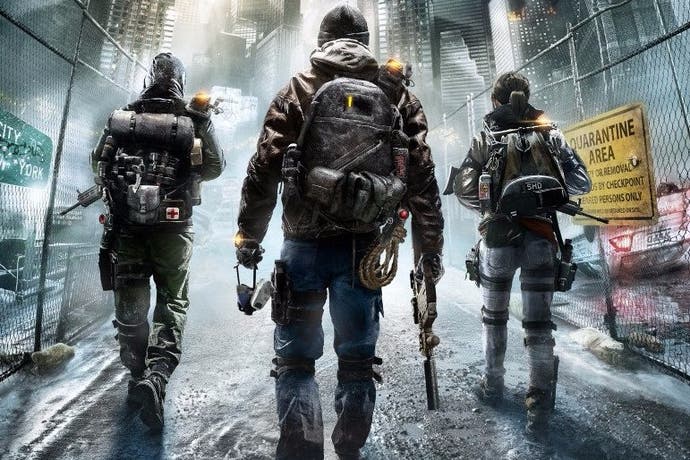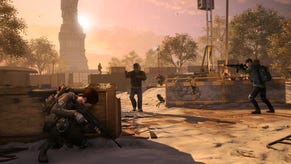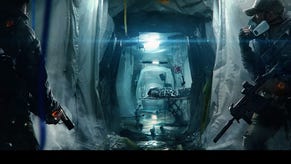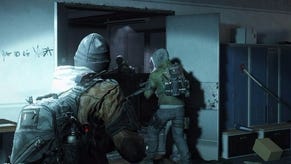Tech Analysis: The Division on PC
How the PC code improves over console, and what it takes to run the game at 1080p60.
The Division's recent beta impressed us on a visual level on both PlayStation 4 and Xbox One, particularly in terms of its lighting, effects work and solid performance - but it's on PC where Ubisoft Massive's technology really comes to the fore. You're going to need top-tier hardware to get the most out of the game at 60fps, but initial impressions suggest that there's enough scalability in the engine to get a good experience across a range of hardware.
But let's talk image quality first. On a basic level, The Division offers up the standard goodies we expect from a PC port: the ability to run at an arbitrary resolution of your choosing, plus enhanced anti-aliasing options. Four levels of SMAA 1x post-processing are available, combined with two forms of temporal AA - stabilisation and super-sampling. The latter option is the one to pick, drawing upon visual information rendered in previous frames for superior edge-smoothing, while stabilisation is a much more basic affair with less refinement. Frame-rate caps are available too at 30, 60 and 120fps, though unfortunately these are not accompanied by proper frame-pacing when v-sync is engaged, meaning Nvidia owners will need to dip into their GPU control panels to activate this at a driver level.
Certain other benefits come to the fore by running the PC version on maxed. Firstly, there's the draw distance; we have an 'extreme streaming distance' slider in its options, which affords us fewer instances of pop-in on shadows and distant objects. From the very first helicopter fly-by scene, it's apparent PC already loads much of the geometry on show ahead of time, while PS4 still visibly draws these elements in on-the-fly. The extent of the difference is less apparent while walking New York's streets, but it's one distraction PC can happily side-step, as long as greater GPU resources are available.
Perhaps the more enviable difference is in shadow quality. PC offers a multitude of modes in this area, including presets for spot and contact shadows - plus the expensive Nvidia PCSS option. Outdoors, this mode gives shadows a more diffused appearance than the console versions, and takes into account an object's distance from scenery when casting long shadows. The results are more natural in some cases, and while indoors, the setting logically creates crisper outlines to character shadows when stood directly near to a wall. Shadow resolution also gets a noticeable push on PC too, avoiding one of the few rough spots on the PS4 and Xbox One versions. The consoles do use something close to PC's top-end ambient occlusion setting, though this falls short of Nvidia's more pleasing HBAO+ mode.
Another big plus for the maxed PC experience is higher precision reflection maps. Puddles in the road mirror spot lights and nearby geometry with greater sharpness at PC's ultra setting (though window reflections on buildings run at the same quality). It creates a more vibrant scene at times, especially with the Christmas lights dangling overhead, and it edges the PC build slightly back towards the look of its original E3 2013 reveal.
However, there's still a lot of commonality between PC and console overall; texture quality, plus the distinctive volumetric fog effect appear to run at a similar quality on each. It's an impressive-looking game on all formats, but for PC the boosts in draw distance, shadow and reflection quality, and also the use of higher quality SMAA, are the main plus points. Away from the visual points though, PC enjoys clear gameplay advantages - the jump to 60fps makes the game feel better to play, and controller response is tighter as well.
In terms of performance, an initial look at The Division shows promise, but what's clear is that pushing the title on the high and ultra presets requires an accomplished spec. On the plus side, CPU utilisation looks solid. The game appears to utilise as many threads as you can throw at it - a quad-core i7 shows even balance across all eight threads, while testing on a six-core 3930K shows a similar story across 12. A Core i3 processor should be good for maintaining a baseline 30fps with relative comfort - the exception being in loading time length. Curiously, load times are tied directly to CPU power, and the gulf between i3 and i7 (both running from an SSD) is often palpable. Even the i7s see all threads maxed here, a situation that thankfully does not persist into gameplay where an i7 4790K overclocked to 4.6GHz sees utiilsation in the 40-50 per cent area when paired with a GTX 970.
The Division is a demanding game from a GPU perspective though. Our budget PC, featuring a Core i3 4130 and an overclocked GTX 750 Ti, saw frame-rates in the early to late 20s running at high settings - while pushing that up to a GTX 950 saw performance rise to 27-40fps. Once the game is final, we'll need to revisit our settings balance here with a closer lock to console-equivalent presets. However, what is comforting is that The Division's VRAM optimisation scales according to your hardware, and on a 2GB card we note 1.8GB usage, rising to 3.5GB on a 4GB offering.
Ramping up the game to ultra settings, and moving on to an i7 4790K paired with GTX 970 and R9 390, two observations are clear: firstly, we're looking at minimum frame-rates on both cards in 35fps territory, but the AMD hardware shows a clear advantage over Nvidia in engine-driven cut-scenes and lower detail locations. This can rise to anything up to 15-20fps. It's a remarkable advantage, and one that is sustained for much of the run of play in the beta, since most of the action occurs indoors. The advantage is even more noteworthy in that Nvidia released a game-ready driver for the beta, whereas AMD didn't - we used the most recent 16.1 Radeon Crimson hotfix driver for our testing.
However, our chosen stress test - the street shoot-out when seizing your base of operations - sees a significant performance drop on AMD, where it only narrowly outperforms the GTX 970. It's an interesting example of how benchmarking specific games can see performance differentials between the two vendors change significantly according to context. Regardless, 1080p60 on ultra is off the table for both cards - we got closer by dropping down to high settings with medium shadow resolution. This improved in-game fluidity no end, but it required a meaty +200MHz core overclock along with +400MHz to the memory in order to get the GTX 970 to more consistently hit the target. Generally speaking, we don't recommend overclocking the R9 390 beyond the 1050-1070MHz territory seen in factory-overclocked cards - power consumption and heat generation rise enormously.
We also took some time to try The Division on a GTX 980 Ti. Unfortunately, Fury X wasn't available for equivalent testing but regardless, results on the Nvidia hardware at top-end settings are better than expected. 4K resolution is doable at 30fps with judicious settings tweaks, dropping down from ultra to high, but computationally expensive effects like depth of field and lavish use of volumetric lighting can still see frame-rates dip beneath 30fps.
There's better news at 1440p, where high settings with medium shadow resolution can get you very close to a locked 60fps. Our results here further cement our contention that the latest and greatest graphics hardware from Nvidia and AMD struggle to live up to their 4K billing. As it turns out here, 1440p and its ultra-wide variant are the true sweet spot for this top-end hardware.
Overall, we've only had a limited time with The Division, but what's clear is that the visual improvements compared to the console builds are accomplished, but there is a clear demand on graphics hardware to deliver all visual upgrades - maintaining a minimum 30fps on high settings in intense outdoor action is going to require a GTX 960 or R9 380 to get the job done. The variability in performance can be dramatic, and we can't help but wish that the dynamic resolution scaling tech found in the Xbox One version was also an option on PC too.
Hopefully a more forensic look at the visual make-up of the console versions will allow us to reclaim some GPU cycles with further settings tweakery, but for now, the message is clear: The Division is a beautiful game, but its visual demands at the high and ultra levels are not to be taken lightly.
Additional reporting by Thomas Morgan.
If you're looking for a little bit of help with the game, our Division guide is up on the site now.












